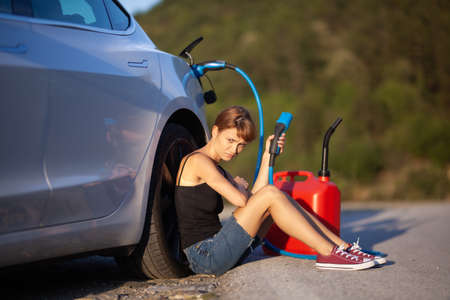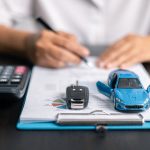1. Introduction to Liability Insurance
Liability insurance is one of the most important types of car insurance in the U.S. It is required in nearly every state and provides financial protection if you cause an accident that results in injury or property damage to others. Understanding how liability insurance works can help you stay compliant with the law and avoid significant financial burdens.
What Is Liability Insurance?
Liability insurance is a type of auto insurance that covers the costs of damage or injuries you cause to other people in an accident. However, it does not cover your own injuries or vehicle damages. This insurance is designed to protect other drivers, pedestrians, and property owners from financial loss due to your actions.
Why Is Liability Insurance Required?
Liability insurance is required in almost every U.S. state because it ensures that drivers can take financial responsibility if they cause an accident. Without it, accident victims might struggle to receive compensation for medical bills and vehicle repairs. By mandating liability coverage, states help protect all road users from unexpected financial loss.
What Does Liability Insurance Cover?
Liability insurance is typically divided into two main components:
| Coverage Type | What It Covers |
|---|---|
| Bodily Injury Liability (BIL) | Covers medical expenses, lost wages, and legal fees if you injure another person in an accident. |
| Property Damage Liability (PDL) | Pays for damages to another person’s vehicle, home, or other property when you are at fault. |
Minimum Liability Insurance Requirements
Each state sets its minimum required liability insurance limits. These limits are usually written as three numbers, such as 25/50/25, which represent:
- First number: Maximum coverage for one injured person (e.g., $25,000).
- Second number: Maximum total coverage for all injured persons in an accident (e.g., $50,000).
- Third number: Maximum coverage for property damage (e.g., $25,000).
The required limits vary by state, so it’s important to check your specific state laws to ensure compliance.
Who Needs Liability Insurance?
Every driver who operates a vehicle in the U.S. needs liability insurance unless they live in one of the few states that allow an alternative, such as a large cash deposit or bond. Without liability insurance, you may face fines, license suspension, or even legal action.
2. Types of Liability Coverage
Liability insurance for car accidents typically includes two main types of coverage: bodily injury liability and property damage liability. These coverages help protect you financially if youre found at fault in an accident.
Bodily Injury Liability (BI)
Bodily Injury Liability (BI) covers medical expenses, lost wages, and legal costs if someone else is injured in an accident you caused. This coverage does not pay for your own injuries but instead helps cover costs for other drivers, passengers, or pedestrians.
What Does Bodily Injury Liability Cover?
- Medical expenses for injured parties
- Lost wages if the injured person cannot work
- Legal expenses if youre sued
- Funeral costs in fatal accidents
Property Damage Liability (PD)
Property Damage Liability (PD) covers the cost of repairing or replacing another person’s property if you are at fault in an accident. This typically applies to other vehicles, but it can also cover damage to fences, buildings, street signs, and other structures.
What Does Property Damage Liability Cover?
- Repairs to another drivers vehicle
- Replacement costs for totaled vehicles
- Damage to fences, buildings, or road signage
- Legal fees if youre sued for property damage
Comparison of Bodily Injury and Property Damage Liability Coverage
| Coverage Type | What It Covers | Who It Covers |
|---|---|---|
| Bodily Injury Liability | Medical bills, lost wages, legal fees | Other drivers, passengers, pedestrians |
| Property Damage Liability | Vehicle repairs, property repairs, legal fees | Other people’s property (cars, buildings, fences, etc.) |
Having both types of liability coverage is essential, as it helps protect you from significant financial loss if youre responsible for an accident. Each state sets minimum coverage requirements, but higher coverage limits may provide better protection in costly accidents.

3. How Liability Insurance Works in an Accident
Understanding how liability insurance comes into play after a car accident can help you navigate the claims process with confidence. Below is a step-by-step breakdown of how liability insurance applies when youre found at fault for a crash.
Step 1: Reporting the Accident
As soon as the accident happens, you should contact your insurance company to report it. Be prepared to provide details such as:
- Time and location of the accident
- Names and contact information of drivers and passengers involved
- Photos or videos of the damage
- A copy of the police report (if available)
Step 2: Investigation by the Insurance Company
The insurance company will assign an adjuster to investigate the accident. This typically involves:
- Reviewing accident details and police reports
- Speaking with witnesses
- Assessing damage to the vehicles
- Determining fault based on state laws
Step 3: Determining Liability Coverage
Liability insurance covers two main areas:
| Coverage Type | Description |
|---|---|
| Bodily Injury Liability (BI) | Covers medical expenses, lost wages, and legal fees for the other party if they are injured. |
| Property Damage Liability (PD) | Pays for repairs to the other party’s vehicle or property you damaged in the accident. |
Step 4: Settlement and Payout
Once fault is determined, your insurance provider will cover eligible expenses up to your policy limits. This may include:
- Medical bills for injured parties
- Repair costs for the other persons vehicle
- Legal defense if youre sued
- Other property damage (such as fences or street signs)
Step 5: Possible Consequences for You
Since you’re at fault, you may experience the following consequences:
- An increase in your insurance premiums
- Financial responsibility if damages exceed your coverage limits
- Points on your driving record, depending on state laws
- Potential legal action if the other party sues
By understanding how liability insurance works, you can better prepare for what happens after an accident and make informed decisions about your coverage needs.
4. Coverage Limits and What’s Not Covered
When you purchase liability insurance for your car, your policy will have coverage limits that determine how much your insurer will pay in the event of an accident. Understanding these limits and what expenses are not covered can help you make informed financial decisions.
Understanding Policy Limits
Liability insurance typically includes two types of coverage:
- Bodily Injury Liability (BIL): Covers medical expenses, lost wages, and legal fees if you cause an injury to another person.
- Property Damage Liability (PDL): Covers repair or replacement costs for another persons vehicle or property.
The policy limits for liability insurance are usually expressed as three numbers, such as 50/100/50. Heres what these numbers mean:
| Limit Type | What It Covers |
|---|---|
| 50 | Maximum amount (in thousands of dollars) the insurer will pay per injured person. |
| 100 | Maximum amount the insurer will pay for all injuries in a single accident. |
| 50 | Maximum amount the insurer will pay for property damage per accident. |
How Coverage Limits Affect Claims
If the damages or injuries exceed your coverage limits, you may be personally responsible for paying the remaining costs. For example, if you have a $50,000 bodily injury liability limit per person, but medical expenses total $75,000, you would need to cover the extra $25,000 out of pocket.
What Liability Insurance Won’t Cover
Liability insurance only covers damages and injuries that you cause to others. It does not cover your own vehicle or medical bills. Here are some common exclusions:
- Your Own Medical Bills: You’ll need personal injury protection (PIP) or medical payments coverage for that.
- Damage to Your Own Car: Collision coverage is required for repairs to your vehicle.
- Theft or Vandalism: Comprehensive insurance covers stolen or damaged vehicles.
- Intentional Damage: If you intentionally cause an accident, your insurer won’t cover the damages.
- Driving for Business Purposes: If you use your personal vehicle for business, you might need commercial auto insurance.
Why Understanding Your Coverage is Important
Knowing your liability insurance limits and exclusions can help you avoid unexpected costs after an accident. If you’re unsure whether your coverage is enough, consider increasing your limits or purchasing additional types of coverage to protect yourself financially.
5. What to Do After an Accident
Being involved in a car accident can be overwhelming, but knowing what steps to take can help protect your rights and make the claims process smoother. Here’s what you should do immediately after an accident.
1. Ensure Safety First
Before anything else, check yourself and others for injuries. If anyone is hurt, call 911 immediately for medical assistance. If the vehicles are drivable and its safe to do so, move them to the side of the road to prevent further accidents.
2. Call the Police
Even for minor accidents, it’s a good idea to report the accident to the police. An official report can provide important documentation for your liability insurance claim.
3. Gather Important Information
Exchange information with the other driver and collect details that will be useful for your claim. Here’s what you should collect:
| Information | Details to Collect |
|---|---|
| Driver’s Info | Full name, phone number, address, driver’s license number |
| Vehicle Details | Make, model, year, color, license plate number |
| Insurance Info | Insurance company name and policy number |
| Accident Location | Street name, nearest intersection, landmarks |
| Police Report Number | If police arrive, ask for the report number |
4. Take Photos and Notes
Use your phone to take pictures of the accident scene, vehicle damage, license plates, and any relevant road signs or signals. Also, jot down notes about what happened while the details are fresh in your mind.
5. Notify Your Insurance Company
Contact your insurance provider as soon as possible to report the accident. Provide them with all the necessary details and follow their instructions on filing a claim.
6. Avoid Common Mistakes When Filing a Claim
Making a mistake when filing a claim can lead to delays or even a denial of coverage. Here are some common pitfalls to avoid:
- Admitting Fault: Never admit fault at the scene, even if you think you were responsible. Let the insurance company and authorities determine liability.
- Failing to Collect Evidence: Lack of documentation can weaken your claim. Always take photos and gather witness statements if possible.
- Not Reporting the Accident: Some drivers hesitate to report minor accidents, but it’s important to notify your insurer to avoid complications later.
- Delaying Medical Attention: If you have any injuries, seek medical attention immediately. Delaying treatment could make it harder to prove injuries were caused by the accident.
7. Cooperate with the Insurance Adjuster
Your insurance company may send an adjuster to assess the damage. Be honest and provide all requested information, but avoid speculating about the accident.
8. Follow Up on Your Claim
Stay in touch with your insurance company to track the progress of your claim. Ask about the timeline and any additional documents needed.
Following these steps will help you handle a car accident efficiently and ensure a smoother insurance claim process.
6. Conclusion and Key Takeaways
Understanding the Role of Liability Insurance
Liability insurance plays a crucial role in protecting drivers from financial responsibility when theyre at fault in an accident. It covers damages and injuries to others, helping to prevent out-of-pocket expenses that could be overwhelming.
Key Points to Remember
| Factor | Explanation |
|---|---|
| What Liability Insurance Covers | Pays for bodily injuries and property damage of others if you’re at fault. |
| What It Does NOT Cover | Does not pay for your own injuries or damages to your own vehicle. |
| Minimum Coverage Varies | Each state has different minimum liability requirements – always check your states regulations. |
| Higher Limits Provide More Protection | Opting for higher liability limits can help avoid paying hefty costs if damages exceed your policys coverage. |
| Liability Insurance is Required in Most States | Most states mandate drivers to carry liability insurance to legally operate a vehicle. |
Tips for Ensuring Adequate Coverage
Choose Higher Limits
Instead of sticking with the minimum required coverage, consider purchasing higher limits to shield yourself from expensive claims.
Bundle Policies
Many insurance providers offer discounts when you bundle auto insurance with other policies like homeowners or renters insurance.
Understand State Laws
Be aware of the specific liability insurance requirements in your state to avoid penalties and ensure legal compliance.
Review Your Policy Regularly
Check your policy periodically to make sure your coverage aligns with current laws and your financial situation.


